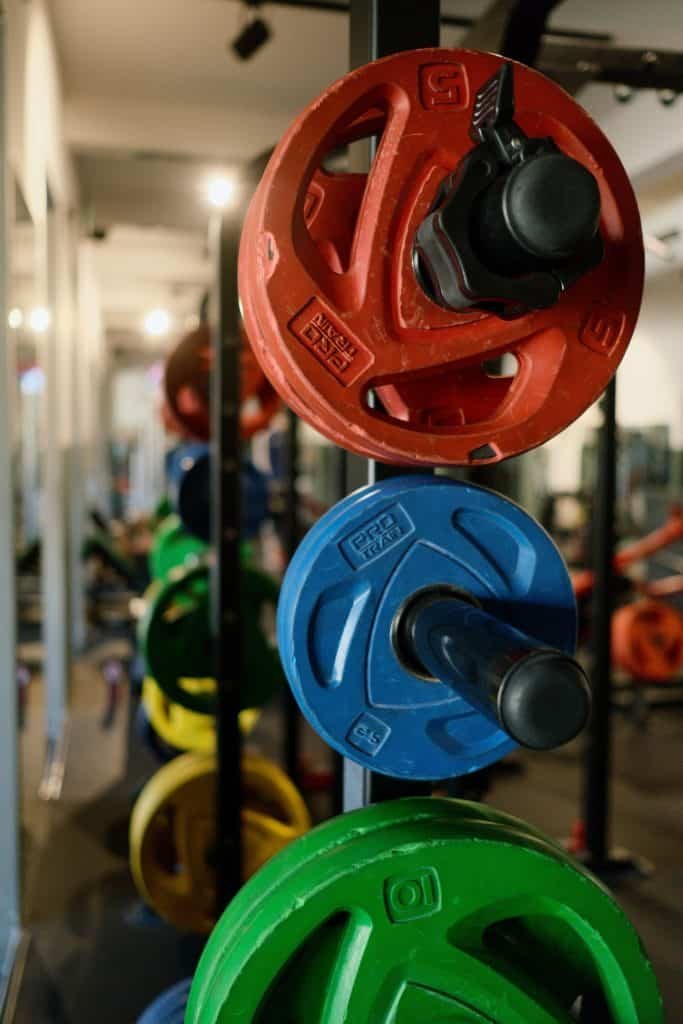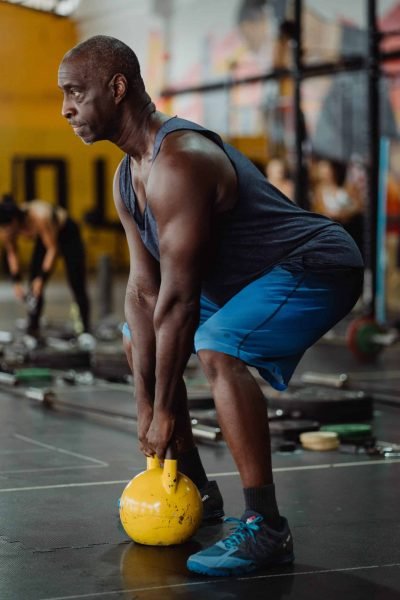Ready to use strength training to boost your cycling or triathlon results?
Here are 5 rules to follow when you hit the weights

Rule #1- Do Not Go From 0-100%
As endurance athletes we’ve come to expect, or taught ourselves and others, that a “good workout” means that you’ve gone 100% and given every last drop of your effort to that workout. While this is true for much of our interval work on the bike, when it comes to strength training, this is the biggest mistake made that ends up pushing you to an injury in the weight room.
I’ve heard it year after year since I began coaching cyclists and triathletes in strength training:
- Last year I hurt my back doing strength training
- Oh I tried strength training, but it makes me too sore to train my bike/swim/run, so I dropped it
- It makes my cycling/ running suffer
But things like this should NOT happen, yet we set ourselves up for it year after year, by pushing too hard, too soon.
As Dr. Stuart McGill and I spoke about on my Strong Savvy Cyclist & Triathlete Podcast in episode 8 & episode 9, many cyclists injure their backs during their strength training as they load up the movements before the tissues (bones, discs, ligaments, tendons, fascia) can handle it.
Be smart. Start with 2-4 weeks of little to no weight for the movements, looking to begin to fire up (“activate”) muscles that you don’t really use in your sport. These movements include side to side movements such as Side Lunge Cross Connect, as well as dynamic warmup movements that open up your shoulders and upper back, such as the Side lying windmill with Foam roller.
Rule #2- Don't Forget Rule #1
We like Warren Buffet’s 2 Rule system to help us remember what’s really important.
In this case, it is Do Not Go Too Hard From The Start!
Soreness is NOT an indicator of a good workout, and in fact is a sign that you did way too much for the body to handle.
Our sports of cycling & triathlon do not require us to handle heavy external loads on the body, which means the tissues and structures of the body- muscles, bones, ligaments, discs of the spine, etc.- are not adapted for these demands.
These adaptations take time, and are one of the reasons why it’s important to follow rule #5, which you’ll learn below. But for now, just remember that you should leave the gym feeling like your sessions was, on a scale of 1-10, a 5, 6, or 7 for the vast majority (90%) of your strength training sessions.
If you want to learn more about this, take a listen to Tony Gentilcore on the Strong Savvy Cyclist & Triathlete podcast.
Rule #3- Master Technique BEFORE Adding Weight

You want to be a great athlete and get as much as you can out of your strength training, right?
Check your ego at the door to the weight room.
Putting more weight on the bar or in your hands have very little to do with whether or not you get out of your strength training what you’d like…which for most triathletes and cyclists is better in-sport performance.
What DOES have a massive impact on getting those results is learning how to move, and to MOVE WELL.
In part because we’re adults, and in part because of our egos, we tend to think that we should load up the bar or movements with as much weight as we possibly can, and that is what will lead us to better sport performances or gains. (I mean, that’s what “the research shows”, right?)
This could not be further from the truth.
It’s not the weight you’re moving, it is HOW you move it, and what your goal outcome is. I wrote a bit about this in more detail in an article for PEZ Cycling News, “Lift Heavy Stuff To Improve Your Cycling”.
The other big mistake many make, is to copy “sport specific” movements in their strength training. This happens in every sport, however, as many come to think that doing “sport-specific movements in the gym” (AKA mimicking sports movements like pedaling with squats and lunges) will help you see gains.
In fact, it won’t. Instead we want to:
- Learn how to perform the FUNdamental 5+1 human movements well
- Give you small successes as we build the movements and skills you need to be successful in the long term
The latter means that we’re teaching you how to recruit and fire muscles that you DON’T use in your sport, and yet they play a role in healthy human movement.
You can read a bit more about the thinking and process here, from Cressey Sports Performance MA-Director of Performance, John O’Neil.
Rule #4- Never Strength Train More Than 2 Days in a Row
While in reality it should REALLY be at least 24 hours between strength training sessions, many cyclists and triathletes treat their strength as an add-on, rather than a pillar of their training. This has led to many sticking their strength training wherever they can fit it in their schedule.
Remember Rule #2, and how the tissues and structures of our body need time to adapt to the stresses? That’s a large part of why we don’t want to strength train more than 2 days in a row.
The body needs time, nutrients, and rest in order to recover and ADAPT between stressors. As endurance athletes we tend to suck at this, as we often think that more is more.
Be kind to your body, and start to treat strength training as one of the 4 pillars of top health and performance, and you’ll see some amazing results over time.
But that starts with giving the body what it needs between sessions to recover and adapt.
Top cycling coach Tim Cusick shared his hard-earned insights into the importance of adaptation on episode 159 of the Strong Savvy Cyclist & Triathlete Podcast.
Included in Rule #4 is to make sure you’re eating 1.6g/kg of protein + per day. The more strenuous your strength + in-sport training, the more you’ll want to trend towards 2.0g/kg.
This last point about in-season nutrition leads us to the 5th rule. And it’s a BIG. DEAL.
Rule #5- Strength Training MUST be done Year-Round

This 5th rule is the Topper that so many endurance athletes ignore, and many well-meaning coaches neglect:
In order for strength training to have its desired effects, it MUST be done YEAR-ROUND.
Yoga, Pilates, TRX, and Bodyweight exercises don’t count, although they do serve a role.
Let’s play a game… Let’s pretend….

Let’s pretend I’m your coach, and I give you this awesome, absolutely amazing cycling/swimming/running training program that has you kicking butt and just crushing your PR’s as you get into the end of February.
Then on March 1, I send you an email that says the following:
“Hey there Superman/Superwoman!
You’ve been absolutely CRUSHING it the last 5 months, and I’m SUPER proud of you and how well you’ve been doing. You’re moving better, putting out more power with less effort, and you’ve been less sore than in years past.
However, the time has come that we cease all cycling/swimming/running training, as we don’t want it to drain you of your day to day abilities, and, well, we really need to focus on your recovery much more until your “A” event July 27th this summer.
In order to keep you in shape, we’ll be doing 2x a week of 30 minutes riding on the trainer, but don’t actually make it so the trainer works, just put your bike on it and spin the pedals with zero resistance. Oh, and if you begin to feel like you’re working, pedal even slower, because we can’t waste any energy on this.
Awesome job, keep it up!
-Coach
I sincerely hope you would fire me faster than a kindergartener getting dropped off the pro peloton. Yet this is EXACTLY how the vast majority of coaches and athletes treat their strength training:
- 3-4 months weights
- No strength except “core” or “bodyweight” for the rest of the year
It is so incredibly outdated, and silly, that this is one of those myths that MUST die.
Yes, if you crush yourself every day with your strength routine you will not see results in your sport (see Rule #2), as you’ll be sapping the body of the energy it needs to train in-sport.
In order to keep your gains, you have to keep up your strength training year round. This doesn’t mean super heavy, but it does mean heavy enough, or challenging enough to keep slight stimulation on the muscles and systems involved to see some results.
Conclusion
Strength Training, when done properly, offers cyclists and triathletes massive benefits to their bodies ability to be resilient, continue to build fitness, and have fewer aches, pains, and training days lost to injury, however one must follow the 5 rules laid out here today.
While simple, they are also incredibly easy- just like the results and improvements you’ll see when you first begin following them. These initial gains will come quickly and have you thinking “Gosh, if I’m getting this strong and moving better is this easy, I should push harder/do more!”………………..

Don’t.
Just don’t even.
Strength training, when done right, is slightly challenging, with the magic being in the consistency, doing the right things that balance out the sport-specific movements you already get 10,000+ times in each training session, and allow you to have better posture and coordination throughout your body.
If you’d like to learn more about how to get far more out. of your strength training for triathlon or cycling, sign up for the HVTraining Newsletter here to get weekly emails every Friday with new strength exercises, and much more.
Until Next time, Train Smarter, Not Harder, because it is all about YOU!
(LEARN) If you’re a coach, personal trainer, or self-coached cyclist looking to learn the most up to date and best practices in strength training for cyclists, sign up for the Strength Training for Cyclists Certification Insiders List!
The Strength Training for Cyclists Certification has helped hundreds of coaches from around the world learn how to assess their riders on and off the bike, and to build cycling-specific strength training programs that get their riders stronger, faster, and moving better than ever!






